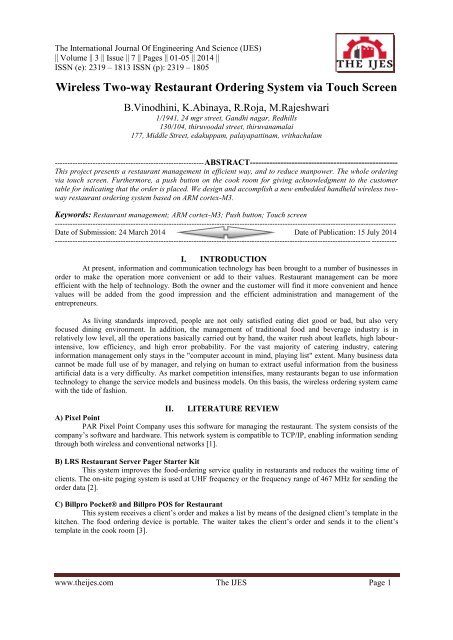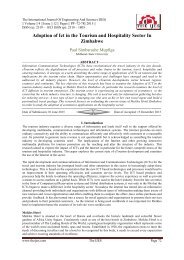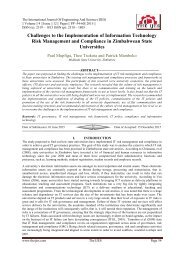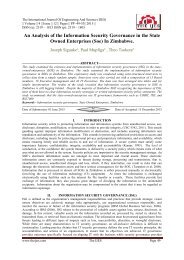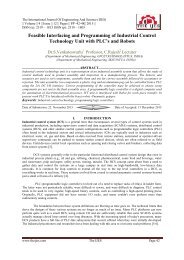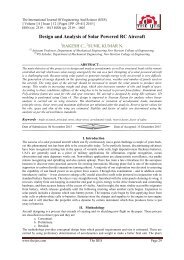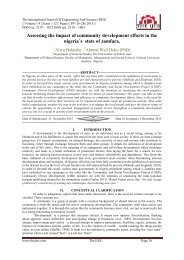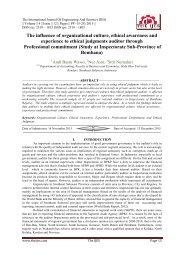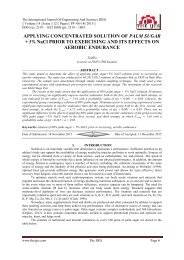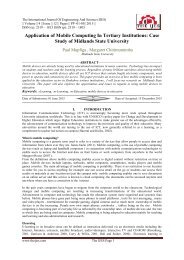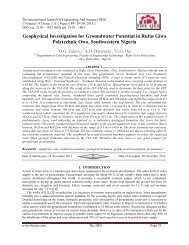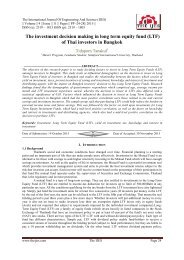Wireless Two-way Restaurant Ordering System via Touch Screen
Create successful ePaper yourself
Turn your PDF publications into a flip-book with our unique Google optimized e-Paper software.
The International Journal Of Engineering And Science (IJES)<br />
|| Volume || 3 || Issue || 7 || Pages || 01-05 || 2014 ||<br />
ISSN (e): 2319 – 1813 ISSN (p): 2319 – 1805<br />
<strong>Wireless</strong> <strong>Two</strong>-<strong>way</strong> <strong>Restaurant</strong> <strong>Ordering</strong> <strong>System</strong> <strong>via</strong> <strong>Touch</strong> <strong>Screen</strong><br />
B.Vinodhini, K.Abinaya, R.Roja, M.Rajeshwari<br />
1/1941, 24 mgr street, Gandhi nagar, Redhills<br />
130/104, thiruvoodal street, thiruvanamalai<br />
177, Middle Street, edakuppam, palayapattinam, vrithachalam<br />
-----------------------------------------------------------ABSTRACT-----------------------------------------------------<br />
This project presents a restaurant management in efficient <strong>way</strong>, and to reduce manpower. The whole ordering<br />
<strong>via</strong> touch screen. Furthermore, a push button on the cook room for giving acknowledgment to the customer<br />
table for indicating that the order is placed. We design and accomplish a new embedded handheld wireless two<strong>way</strong><br />
restaurant ordering system based on ARM cortex-M3.<br />
Keywords: <strong>Restaurant</strong> management; ARM cortex-M3; Push button; <strong>Touch</strong> screen<br />
---------------------------------------------------------------------------------------------------------------------------------------<br />
Date of Submission: 24 March 2014 Date of Publication: 15 July 2014<br />
----------------------------------------------------------------------------------------------------------------------------- ----------<br />
I. INTRODUCTION<br />
At present, information and communication technology has been brought to a number of businesses in<br />
order to make the operation more convenient or add to their values. <strong>Restaurant</strong> management can be more<br />
efficient with the help of technology. Both the owner and the customer will find it more convenient and hence<br />
values will be added from the good impression and the efficient administration and management of the<br />
entrepreneurs.<br />
As living standards improved, people are not only satisfied eating diet good or bad, but also very<br />
focused dining environment. In addition, the management of traditional food and beverage industry is in<br />
relatively low level, all the operations basically carried out by hand, the waiter rush about leaflets, high labourintensive,<br />
low efficiency, and high error probability. For the vast majority of catering industry, catering<br />
information management only stays in the "computer account in mind, playing list" extent. Many business data<br />
cannot be made full use of by manager, and relying on human to extract useful information from the business<br />
artificial data is a very difficulty. As market competition intensifies, many restaurants began to use information<br />
technology to change the service models and business models. On this basis, the wireless ordering system came<br />
with the tide of fashion.<br />
II. LITERATURE REVIEW<br />
A) Pixel Point<br />
PAR Pixel Point Company uses this software for managing the restaurant. The system consists of the<br />
company‟s software and hardware. This network system is compatible to TCP/IP, enabling information sending<br />
through both wireless and conventional networks [1].<br />
B) LRS <strong>Restaurant</strong> Server Pager Starter Kit<br />
This system improves the food-ordering service quality in restaurants and reduces the waiting time of<br />
clients. The on-site paging system is used at UHF frequency or the frequency range of 467 MHz for sending the<br />
order data [2].<br />
C) Billpro Pocket® and Billpro POS for <strong>Restaurant</strong><br />
This system receives a client‟s order and makes a list by means of the designed client‟s template in the<br />
kitchen. The food ordering device is portable. The waiter takes the client‟s order and sends it to the client‟s<br />
template in the cook room [3].<br />
www.theijes.com The IJES Page 1
<strong>Wireless</strong> <strong>Two</strong>-<strong>way</strong> <strong>Restaurant</strong> <strong>Ordering</strong> <strong>System</strong> <strong>via</strong> <strong>Touch</strong> <strong>Screen</strong><br />
D) <strong>Restaurant</strong> <strong>System</strong> by Ericsoft<br />
This program administers and manages general restaurant services wirelessly. Food ordering is taken<br />
by waiters who then order the cashier, who in turn tells the cook room what to cook [4].<br />
E) Implementation of Network-based Smart Order <strong>System</strong><br />
The Smart Order <strong>System</strong> in <strong>Restaurant</strong>s (SOSIR) has been modified to take order from the client‟s<br />
table Through RS-232 signal, this is sent to the cashier counter. The cashier counter system is connected to a<br />
database. When the clients‟ orders are sent the cashier counter system will screen and prioritize the orders<br />
Before sending the information to the kitchen for the chef to cook [5].<br />
Table 1 shows the comparison of functions of each system. In general, most systems are already based<br />
on wireless network and touch screen. However, the disadvantages include the missing of an efficient waiter<br />
calling system and checking of order status in order to lessen customers‟ anxiety.<br />
III. SYSTEM DESIGN<br />
By gathering each benefit from various previous works, this paper aims to implement a restaurant<br />
ordering system which enables each customer to wirelessly order his own choice of food straight from the e-<br />
menu shown on an embedded touch screen on each customer table without bothering any staff and send the<br />
order straight to the cook room. The whole food process can also be monitored <strong>via</strong> this touch screen.<br />
The existing system, the design implementation using ARM9 s3c2410.The performance which is 3<br />
times lesser when compared with cotex-M3 .In the case of multiple interrupt, the response time is quite higher.<br />
It is not configurable. Typically 220 MIPS @200MHZ.<br />
The proposed system consists of three main components, namely, a touch screen embedded on the<br />
customer table, a main server and another touch screen in the cook room, shown in Figure 1. When the customer<br />
orders food, the data is sent to the server, which will compile the data in order to prioritize the customers and to<br />
group the orders before sending the order to the cook room. The status shown at the client‟s table is „waiting for<br />
food‟.<br />
www.theijes.com The IJES Page 2
<strong>Wireless</strong> <strong>Two</strong>-<strong>way</strong> <strong>Restaurant</strong> <strong>Ordering</strong> <strong>System</strong> <strong>via</strong> <strong>Touch</strong> <strong>Screen</strong><br />
Figure 1: Block of Table Mode<br />
When the order reaches the cook room, the chef will press the „accept‟ button which will show the<br />
cooking stage at the client‟s table. When cooking is done, the chef presses the „waiting for serving‟ stage to the<br />
client‟s table and the server will take the dish to the client.<br />
Power<br />
Management<br />
Circuit<br />
3.3V<br />
Push Button<br />
IEEE 802.15.4<br />
Radio<br />
GPIO<br />
Graphics LCD<br />
SPI-1<br />
ARM Cortex-<br />
M3<br />
SPI-2<br />
GPIO<br />
Buzzer<br />
Figure 1: Block of Kitchen Mode<br />
www.theijes.com The IJES Page 3
<strong>Wireless</strong> <strong>Two</strong>-<strong>way</strong> <strong>Restaurant</strong> <strong>Ordering</strong> <strong>System</strong> <strong>via</strong> <strong>Touch</strong> <strong>Screen</strong><br />
This food ordering system is capable of informing the food status when the menu has been ordered <strong>via</strong><br />
wireless touch screen communication network. The touch screen is the system‟s input-output device. Besides,<br />
waiters can be called using the table device by pressing the “Call Waiter” button, which will immediately<br />
activate the buzzer.<br />
Power<br />
Management<br />
Circuit<br />
3.3V<br />
SPI-1<br />
ARM<br />
Cortex-M3<br />
SPI-2<br />
IEEE 802.15.4<br />
Radio<br />
Graphics LCD<br />
Figure 3: Block of Billing Mode<br />
Database comprises 2 major components. The first<br />
Is the food table which is used to store menus including dish names and prices, the date this dish was added,<br />
types and additional information. (Figure: 3)<br />
<br />
<br />
<br />
<br />
<br />
<br />
IV. EXPERIMENTS AND RESULT<br />
When the „menu‟ button is pressed, the menu Will appear on the touch screen as in Figure1.<br />
Send the food orders to the kitchen.<br />
Receive notification from the kitchen Figure2<br />
Waiters can be called using the table device by pressing the “Call Waiter” button, which will<br />
immediately activate the buzzer.<br />
know the total price that the customer in certain table must pay Figure3.<br />
Figure 4: Hardware design<br />
V. CONCLUSIONS AND FUTURE WORK<br />
This paper presents a wireless two-<strong>way</strong> restaurant <strong>Ordering</strong> system which gathers a number of<br />
advantages of existing works and work <strong>via</strong> touch screens at three different units: customer tables, cook room<br />
and main server. However, the operation based on “Any Client By One Server Respond” is questionable<br />
because the next client has to wait until the client being serviced is taken care of before he can connect to the<br />
server. One <strong>way</strong> to solve this problem is to use the Thread Server Respond as shown in Figure 5.<br />
www.theijes.com The IJES Page 4
<strong>Wireless</strong> <strong>Two</strong>-<strong>way</strong> <strong>Restaurant</strong> <strong>Ordering</strong> <strong>System</strong> <strong>via</strong> <strong>Touch</strong> <strong>Screen</strong><br />
Figure 4: One Client One Server Respond<br />
The three order statuses are also difficult to understand because when the status shows that the order is<br />
„waiting to be served‟ and the assistant already takes the food to the client, the status still shows „waiting to be<br />
served‟. Thus, we should add the status, „already served‟ for ease of understanding.<br />
REFERENCES<br />
[1] PAR PixelPoint “PixelPoint POS Brochure”, Available http://www.pixelpointpos.com [Accessed: 11 May 2011]<br />
[2] Advanced Analytical, Inc (October 2004) “LRS <strong>Restaurant</strong> Server Pager”, Available http://foodsoftware.com/Product_0132.asp<br />
[Accessed: 11 May 2011]<br />
[3] Billpro Pocket® and Billpro POS for <strong>Restaurant</strong> Available:<br />
http://www.zujic.cz/zatyoo/en/Billpro_EN/Billpro_Pocket.ht m [Accessed: 16 October 2010]<br />
[4] Ericsoft.com, “Technical data sheet”, Available http://www.ericsoft.com [Accessed: 16 October 2010]<br />
[5] M.H.A. Wahab, H.A. Kadir, N. Ahmad, A.A. Mutalib and M.F.M. Mohsin, “Implementation of network-based smart order<br />
system,” International Symposium on Information Technology 2008 (ITSim 2008), pp. 1-7, 2008<br />
www.theijes.com The IJES Page 5


